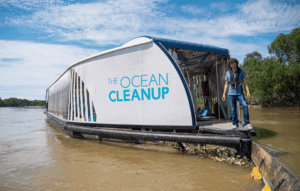Chlorine has been heavily relied on for water sanitation, providing a powerful tool to kill pathogens in attempts to protect public health. In cities all around the world, chlorine is used to disinfect drinking water, control bacterial growth, and ensure our tap water is free from disease-causing microbes. But while chlorine has transformed public health, its widespread use comes at a hidden environmental cost. When released into natural ecosystems, chlorine and its chemical byproducts can wreak havoc on aquatic life, harm biodiversity, and disrupt fragile ecological balances.
This article uncovers how chlorine travels from water treatment plants to the environment, its impact on ecosystems, and alternative approaches we should consider to help mitigate these effects.
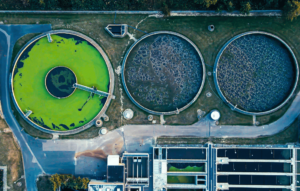
Chlorine in Water Systems
People are familiar with chlorine because it’s such an effective tool for killing bacteria, viruses, and other pathogens in water. Water treatment facilities add chlorine to drinking water and wastewater to prevent waterborne diseases. This process, known as chlorination, plays an essential role in public health by controlling pathogens like E. coli, Salmonella, and Giardia.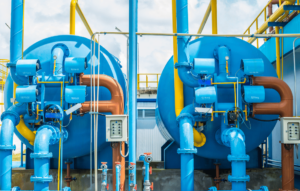
People are less familiar with the unintended consequences of chlorination. When chlorine interacts with organic matter in water, it creates a series of chemical byproducts, including trihalomethanes (THMs) and haloacetic acids (HAAs). These byproducts are highly toxic and can have long-lasting effects on both human health and the environment. Although regulations control the levels of these byproducts in drinking water, they still find their way into natural water systems when wastewater is released or stormwater runoff occurs.
Environmental Pathways of Chlorine
Once chlorine-treated water is released, chlorine and its byproducts begin to move through natural waterways. There are several key ways chlorine enters the environment:
- Wastewater Discharge: Treated wastewater containing chlorine and chlorine byproducts is often discharged into rivers, lakes, and oceans.
- Agricultural Runoff: Chlorinated water used for agricultural purposes can seep into nearby bodies of water through irrigation runoff.
- Industrial Effluents: Industrial facilities use chlorine in processes such as paper bleaching and textile manufacturing, and wastewater from these industries often contains residual chlorine.
Chlorine and its byproducts can persist in these natural ecosystems, affecting water quality and posing serious risks to wildlife.
Effects on Aquatic Ecosystems
The introduction of chlorine into aquatic environments has a variety of concerning effects. Here’s how chlorine and its byproducts impact different components of aquatic ecosystems:
Aquatic Toxicity
Chlorine is highly toxic to fish, amphibians, and invertebrates, even in low concentrations. Exposure to chlorine can cause respiratory issues in fish, as it damages their gills, making it harder for them to absorb oxygen. Chlorine also affects the nervous and reproductive systems of aquatic organisms, which can result in impaired growth, reduced reproductive success, and, in severe cases, death.
Bioaccumulation
Chlorine byproducts like trihalomethanes can accumulate in aquatic organisms over time. This bioaccumulation can make smaller organisms toxic to their predators, leading to a chain reaction throughout the food web. In this way, chlorine pollution threatens not only individual species but entire aquatic ecosystems, as toxins move up the food chain.
Biodiversity Impact
Chlorine pollution can reduce biodiversity by creating inhospitable environments for sensitive species. Aquatic plants and invertebrates are particularly vulnerable to chlorine’s toxic effects, and their decline disrupts the food web, affecting predators and competitors alike. A loss of biodiversity can destabilize ecosystems, reducing their resilience to changes like climate shifts or additional pollutants.
Chlorine’s Broader Environmental Impact
Beyond its direct toxicity to aquatic organisms, chlorine pollution has a range of indirect effects that further harm ecosystems:
Algal Blooms
Chlorine and its byproducts can trigger toxic algal blooms in water bodies. Although chlorine can suppress algae in controlled environments like swimming pools, in natural settings, it disrupts the balance of microorganisms, sometimes encouraging the growth of harmful algae and other harmful pathogens. Algal blooms deplete oxygen in water, creating dead zones where aquatic life cannot survive. These blooms also release toxins that further endanger fish, shellfish, and other species.
Soil and Plant Health
When chlorine-laden water reaches the soil, it affects microorganisms that play crucial roles in nutrient cycling. Over time, chlorine can degrade soil health, impacting plant growth and reducing the resilience of ecosystems near contaminated water sources.
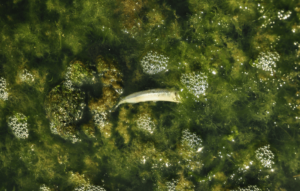
Steps Towards Safer Water Treatment
While chlorine’s role in water safety cannot be understated, there are alternative treatment methods that reduce or eliminate chlorine’s environmental impact. Here are some of the most promising approaches:
- UV Treatment: Ultraviolet (UV) treatment uses UV light to disinfect water, effectively killing pathogens without leaving chemical residues. UV systems are especially effective for small to medium-sized treatment facilities and are gaining traction as a greener alternative.
- Ozonation: Ozonation is a method that uses ozone gas to disinfect water. Ozone is a powerful oxidizing agent that breaks down contaminants and kills pathogens. Although it requires more energy than chlorination, it leaves no toxic byproducts and is much less harmful to the environment.
- Advanced Filtration: Combining filtration with methods like UV and ozonation can produce very high-quality water. Filters remove large particles and reduce organic matter, minimizing the potential for harmful byproducts.
- Better Wastewater Management: Improving wastewater treatment processes and minimizing the use of chlorine in non-essential applications can reduce chlorine pollution. Recycling treated wastewater and controlling stormwater runoff also help limit the amount of chlorine that enters natural ecosystems.
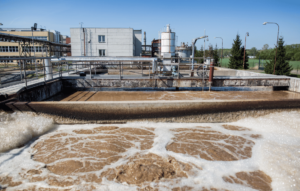
Closing Thoughts
Chlorine has undoubtedly played an important role in modern public health, helping to make water safer for millions worldwide. However, its unintended consequences on the environment are a growing concern; one that we would be foolish to overlook as a society. Chlorine pollution affects fish, amphibians, plants, and entire ecosystems, disrupting food chains and reducing biodiversity. While complete elimination of chlorine in water treatment may not be feasible, alternative methods like UV treatment, ozonation, and advanced filtration offer promising pathways for minimizing environmental harm.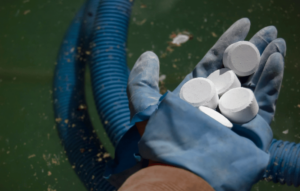
Protecting water ecosystems is a global responsibility, and supporting eco-friendly water treatment practices and initiatives can make a meaningful difference in the future of our planet. Whether it’s by advocating for sustainable practices or simply spreading awareness of chlorine’s environmental impact, we can all contribute to a healthier planet for generations to come. The planet is counting on us to be responsible stewards, so let’s all do our part.


